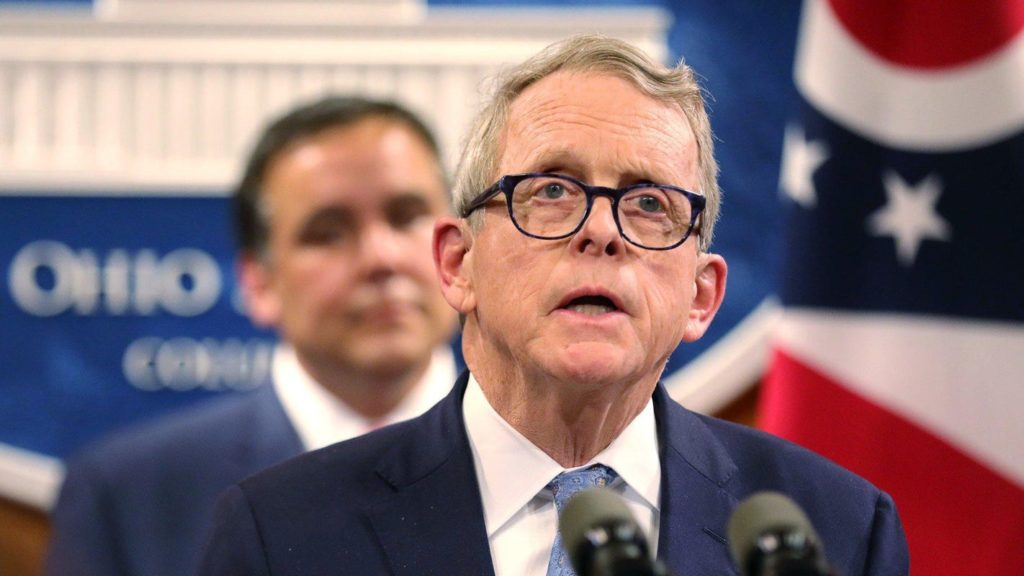

Republican Mike DeWine defeated Democrat Richard Cordray to become Ohio’s next Governor. Political pundits labeled the race a “toss-up” and pollsters had the race as a tie, within the margin of error leading up to Election Day. However, Governor-elect DeWine pulled away with a win of over 4 percentage points, 50.7% to Mr. Cordray’s 46.4%.
With 52% of registered Ohioans voting, DeWine garnered the third highest vote count with over 2.1 million in the state’s history. Even in defeat, Mr. Cordray received the fifth highest vote count in Ohio’s history at over 2 million.
Governor-elect Mike DeWine and his running mate, current Secretary of State Jon Husted will be sworn into their new positions leading Ohio on Monday, January 19th, 2019.
Leading to the victory was DeWine’s overwhelming support in Ohio’s rural communities. DeWine won 79 out of Ohio’s 88 counties, with over two-thirds the vote in 35 counties. Cordray won nine of Ohio’s more populated counties including those that contain Cleveland, Cincinnati, Columbus, Toledo and Youngstown.
Following the Election, political leaders from both parties rationalized DeWine’s victory to President Trump. Exit polls from Election Day showed 52% of Ohioans approve of the job President Trump is doing compared to 45% nationally.
Overall Republicans did well in Ohio, with the “blue wave” skipping over much of the state. Republicans swept the non-judicial statewide offices, maintained their majorities in the Ohio General Assembly and held onto their incumbents in Congress.
Current State Auditor Dave Yost defeated former U.S. Attorney General, 53% to 47%, to become Ohio’s next Attorney General. State Senator Frank LaRose will serve as Ohio’s next Secretary of State with a 51% to 46% victory over State Representative Kathleen Clyde. Former Ohio Senate President and current State Representative Keith Faber won race for Auditor over former Congressman Zack Space by a 50% to 46% margin. State Representative Robert Sprague defeated Cincinnati attorney Rob Richardson 54% to 46% and will serve as Treasurer of State.
Democrats did receive victories in the two open seats on the Ohio Supreme Court. Eighth District Court of Appeals Judge Melody Stewart, by a 52% to 48% margin, defeated Justice Mary DeGenaro. Cuyahoga County Common Pleas Court Judge Michael Donnelly secured a victory over Fifth Court of Appeals Judge Craig Baldwin with a 61% to 39% win. In Ohio, judicial races do not include party affiliation on the ballot. However, in the next year, Republicans will hold a majority on court with a five to two seat majority.
The makeup of the 133rd General Assembly will include 24 Senate Republicans, nine Senate Democrats in the upper chamber and 61 House Republicans and 38 House Democrats in the lower one. Democrats gained four seats in the Ohio House, with three from the suburbs of Columbus in Franklin County. Two seats in the Ohio Senate flipped. Republican Michael Rulli defeated current State Representative John Boccieri in the 33rd Senate District race. In the most surprising Election result in Ohio, Democrat Tina Maharath narrowly defeated current State Representative Anne Gonzales for the 3rd Senate District seat. Maharath’s victory was a surprise to political observers, as she was not endorsed by with the state or county Democratic parties.

With the Election concluded, the popularity contest to become the next Ohio House Speaker has begun. The current Speaker is Ryan Smith, who was selected last spring after Speaker Cliff Rosenberger resigned from the Ohio House under an FBI investigation. State Representative Larry Householder, who served as Ohio House Speaker years ago, has made it no secret he intends to challenge Speaker Ryan to control the caucus. It is unlikely the issue will be resolved before the next General Assembly commences in January.
From a federal perspective, Senator Sherrod Brown easily defeated Congressman Jim Renacci. State Treasurer Josh Mandel was running against Senator Brown, but dropped out.
All of Ohio’s Congressional incumbents were victorious including Congressman Troy Balderson, who was first elected during an August 2018 special election. Former Ohio State University and NFL football player Anthony Gonzalez won the seat being vacated by Congressman Jim Renacci, Ohio’s 16th Congressional District.
Youngstown voters defeated an anti-industry charter amendment for the eighth time.
From an oil and natural gas industry perspective, the new Administration offers a fresh opportunity to build a stronger relationship with Ohio’s leadership. Ohio’s rigorous but fair regulations should remain intact. Governor-elect DeWine has stated publicly that he does not want to increase the state’s severance tax. DeWine has also stated publicly that he does not support drilling on state lands.
In September 2018, the Ohio Supreme Court upheld a lower court’s ruling in Dundics v. Eric Petroleum Corporation that oil and natural gas land agents are not exempt from needing an Ohio Real Estate Broker License. And in the opinion of the Court, it stated only a legislative policy fix could allow the exemption.
Injection wells have been getting lots of attention in Ohio’s local communities, in the media and at the Statehouse. Two pending bills in the Ohio House would establish new setback requirements and limit the number of injection well permits that could be issued in a county.
With all of this, 2019 looks to be a very interesting year to come.






